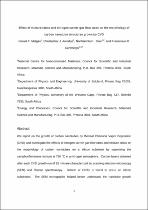 ResearchSpace
ResearchSpace
Effect of mixture ratios and nitrogen carrier gas flow rates on the morphology of carbon nanotube structures grown by CVD
JavaScript is disabled for your browser. Some features of this site may not work without it.
- ResearchSpace
- →
- Research Publications/Outputs
- →
- Journal Articles
- →
- View Item
| dc.contributor.author |
Malgas, GF

|
|
| dc.contributor.author |
Arendse, CJ

|
|
| dc.contributor.author |
Cele, NP

|
|
| dc.contributor.author |
Cummings, FR

|
|
| dc.date.accessioned | 2009-11-17T11:05:27Z | |
| dc.date.available | 2009-11-17T11:05:27Z | |
| dc.date.issued | 2008-02 | |
| dc.identifier.citation | Malgas, GF, Arendse, CJ, Cele, NP and Cummings, FR. 2008. Effect of mixture ratios and nitrogen carrier gas flow rates on the morphology of carbon nanotube structures grown by CVD. Journal of Materials Science, Vol. 43(3), pp 1020-1025 | en |
| dc.identifier.issn | 0022-2461 | |
| dc.identifier.uri | http://hdl.handle.net/10204/3742 | |
| dc.description | Copyright: 2008 Springer-Verlag. This is the author's version of the work. It is posted here by permission of Springer-Verlag for your personal use. Not for redistribution. The definitive version was published in the Journal of Materials Science, Vol. 43(3), pp 1020-1025 | en |
| dc.description.abstract | This paper reports on the growth of carbon nanotubes (CNTs) by thermal Chemical Vapour Deposition (CVD) and investigates the effects of nitrogen carrier gas flow rates and mixture ratios on the morphology of CNTs on a silicon substrate by vaporizing the camphor/ferrocene mixture at 750 C in a nitrogen atmosphere. Carbon layers obtained after each CVD growth run of 15 min are characterized by scanning electron microscopy (SEM) and Raman spectroscopy. Growth of CNTs is found to occur on silicon substrates. The SEM micrographs helped better understand the nanotube growth morphology while Raman spectroscopy was used to detect the presence of nanotubes and also identify their nature vizely semiconducting or metallic, single-walled or multi-walled. Raman Spectra was also useful to estimate the quality of the samples as a ratio of nanotube to non-nanotube content. The length and diameters of the aligned CNTs were found to depend on the pyrolysis temperatures, mixture ratio, and the nitrogen carrier gas flow rates. | en |
| dc.language.iso | en | en |
| dc.publisher | Springer - Verlag | en |
| dc.subject | Carbon nanotubes | en |
| dc.subject | Chemical vapor deposition | en |
| dc.subject | CVD | en |
| dc.subject | Nitrogen carrier gas flow | en |
| dc.subject | Scanning electron microscopy | en |
| dc.subject | Mixture ratios | en |
| dc.subject | Materials science | en |
| dc.subject | Raman spectroscopy | en |
| dc.title | Effect of mixture ratios and nitrogen carrier gas flow rates on the morphology of carbon nanotube structures grown by CVD | en |
| dc.type | Article | en |
| dc.identifier.apacitation | Malgas, G., Arendse, C., Cele, N., & Cummings, F. (2008). Effect of mixture ratios and nitrogen carrier gas flow rates on the morphology of carbon nanotube structures grown by CVD. http://hdl.handle.net/10204/3742 | en_ZA |
| dc.identifier.chicagocitation | Malgas, GF, CJ Arendse, NP Cele, and FR Cummings "Effect of mixture ratios and nitrogen carrier gas flow rates on the morphology of carbon nanotube structures grown by CVD." (2008) http://hdl.handle.net/10204/3742 | en_ZA |
| dc.identifier.vancouvercitation | Malgas G, Arendse C, Cele N, Cummings F. Effect of mixture ratios and nitrogen carrier gas flow rates on the morphology of carbon nanotube structures grown by CVD. 2008; http://hdl.handle.net/10204/3742. | en_ZA |
| dc.identifier.ris | TY - Article AU - Malgas, GF AU - Arendse, CJ AU - Cele, NP AU - Cummings, FR AB - This paper reports on the growth of carbon nanotubes (CNTs) by thermal Chemical Vapour Deposition (CVD) and investigates the effects of nitrogen carrier gas flow rates and mixture ratios on the morphology of CNTs on a silicon substrate by vaporizing the camphor/ferrocene mixture at 750 C in a nitrogen atmosphere. Carbon layers obtained after each CVD growth run of 15 min are characterized by scanning electron microscopy (SEM) and Raman spectroscopy. Growth of CNTs is found to occur on silicon substrates. The SEM micrographs helped better understand the nanotube growth morphology while Raman spectroscopy was used to detect the presence of nanotubes and also identify their nature vizely semiconducting or metallic, single-walled or multi-walled. Raman Spectra was also useful to estimate the quality of the samples as a ratio of nanotube to non-nanotube content. The length and diameters of the aligned CNTs were found to depend on the pyrolysis temperatures, mixture ratio, and the nitrogen carrier gas flow rates. DA - 2008-02 DB - ResearchSpace DP - CSIR KW - Carbon nanotubes KW - Chemical vapor deposition KW - CVD KW - Nitrogen carrier gas flow KW - Scanning electron microscopy KW - Mixture ratios KW - Materials science KW - Raman spectroscopy LK - https://researchspace.csir.co.za PY - 2008 SM - 0022-2461 T1 - Effect of mixture ratios and nitrogen carrier gas flow rates on the morphology of carbon nanotube structures grown by CVD TI - Effect of mixture ratios and nitrogen carrier gas flow rates on the morphology of carbon nanotube structures grown by CVD UR - http://hdl.handle.net/10204/3742 ER - | en_ZA |





